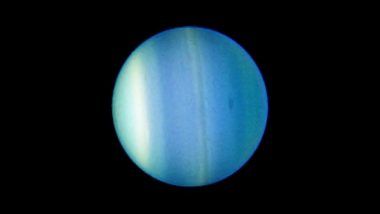Washington, March 21 : One or two of Uranus' 27 moons -- Ariel and/or Miranda -- likely have oceans beneath their icy surfaces and are actively spewing material into the space environment, according to a study by NASA. Previously, Jupiter, Saturn and Neptune were found as hosts to at least one icy moon that's pumping particles into its planetary system. Volcanic Activity on Surface of Venus Detected in Radar Images, Say Scientists.
In the study led by the Johns Hopkins Applied Physics Laboratory (APL) in Maryland, US, researchers reanalysed nearly 40-year-old energetic particle and magnetic field data taken by NASA's Voyager 2 spacecraft -- the only spacecraft so far to have gone to Uranus. NASA Mission to Saturn’s Moon May Unravel Chemistry Leading to Life in Universe.
They found a trapped population of energetic particles the spacecraft had observed while departing Uranus -- the turquoise, tilted oddball of the solar system. "What was interesting was that these particles were so extremely confined near Uranus' magnetic equator," said lead author Ian Cohen, a space scientist at APL.
Magnetic waves within the system would normally cause them to spread out in latitude, he explained, but these particles were all cramped near the equator between the moons Ariel and Miranda.
Scientists originally attributed these features to Voyager 2's possibly having flown through a chance stream of plasma being "injected" from the distant tail of the planet's magnetosphere. But that explanation doesn't hold, Cohen said. "An injection would normally have a much broader spread of particles than what was observed."
The team suspects the particles arise from Ariel and/or Miranda through either a vapour plume similar to that seen on Enceladus or through sputtering -- a process where high-energy particles hit a surface, ejecting other particles into space.
Yet scientists have already suspected Uranus' five largest moons -- Ariel and Miranda included -- may have subsurface oceans. Voyager 2 images of both moons show physical signs of geologic resurfacing, including possible eruptions of water that froze on the surface.
"The data are consistent with the very exciting potential of there being an active ocean moon there," Cohen said. "We can always do more comprehensive modelling, but until we have new data, the conclusion will always be limited."
The findings, recently accepted for publication in the journal Geophysical Research Letters, were also presented at the annual Lunar and Planetary Science Conference in the US.
(The above story first appeared on LatestLY on Mar 21, 2023 03:27 PM IST. For more news and updates on politics, world, sports, entertainment and lifestyle, log on to our website latestly.com).













 Quickly
Quickly












